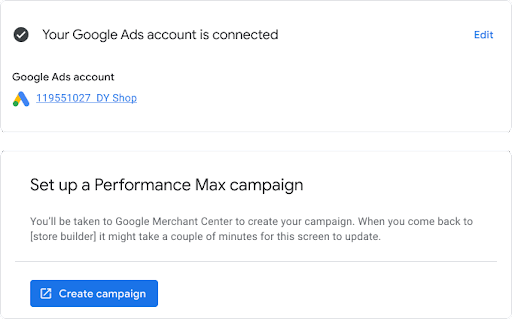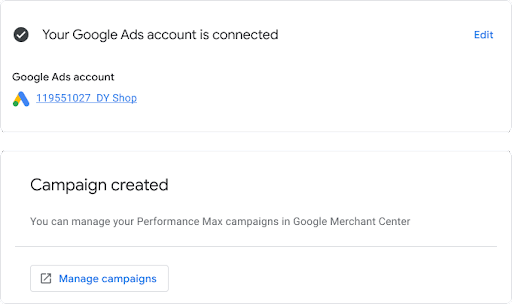4.0.2 Ads Redirect to Merchant Center
Value and Business Impact
For most Ads functionalities in the Foundational pillar, two integration options exist:
Integration through the Google Ads API. Your merchants are able to create and manage campaigns without leaving your website. This provides a more integrated experience, but requires additional efforts to build and maintain your Google Ads integration.
Redirect to Google Merchant Center. Your merchants are able to create their Google Ads account from your website, but create and manage campaigns through Google Merchant Center. This requires merchants to use two different platforms, but significantly reduces the efforts required to build and maintain your Google Ads integration.
Depending on the approach you choose, the steps in this guide may differ. When some steps differ depending on whether you select the redirect approach or not, this is specifically called out. Both approaches have shown comparable performance.
No matter which option you choose, Shopping ads campaigns are visible across platforms. For example, if merchants create a campaign through your website (through the Google Ads API), they are also able to modify the campaign in other platforms such as Google Merchant Center and Google Ads.
Comparison of approaches
You can find below a table summarizing the benefits and drawbacks of each approach:
| Integration through the Google Ads API | Redirect to Merchant Center | |
|---|---|---|
| Effort to implement | High: requires integration through the Google Ads API for every functionality | Low: only minimum Google Ads API integration required (for example, account creation and conversion tracking setup) |
| Effort to maintain | Medium: changes to your integration may be required as Google releases new features | Low: new functionalities launched in Merchant Center is automatically made available to your merchants |
| Merchant experience | Merchants are able to create and manage campaigns without leaving your site (except for billing setup) | Merchants must use another platform to create and manage campaigns. However, they benefit from a simplified interface optimized by Google Ads based on extensive user research |
| Available functionalities | All features available through the Google API, including advanced functionalities (for example, advanced bidding strategies) | Only ads functionalities available in Merchant Center can be used. If merchants need more advanced functionalities, they can use Google Ads. |
Functionalities available through the redirect
Even if you choose the redirect approach, some steps of the Ads onboarding process still require you a Google Ads API integration. Additionally, some of the optional functionalities covered in the Foundational pillar are not available in the redirect; however, advertisers with more advanced needs can then "graduate" to using the Google Ads interface without having to re-upload their products or recreate any of the campaigns they set up in Merchant Center.
A table summarizing which functionalities are covered in the Ads redirect to Merchant Center can be found below.
| Section of the blueprint | Available through Ads redirect to Merchant Center (no Google Ads API integration required) |
Not offered through the Ads redirect to Merchant Center (Manual step or Ads API integration required) |
|---|---|---|
| 4.0 Get Started | - N/A | - Manager account setup - Access level request |
| 4.1 Ads Account setup | - Terms of Service acceptance - Purchase conversion action setup |
- Ads account creation / linking to existing account - Linking a Merchant Center account to a Google Ads account - Dynamic remarketing (optional) - Any advanced functionalities |
| 4.2 Campaign creation | - All campaign creation steps for mandatory fields | - Geo-targeting (optional) - Any advanced functionalities |
| 4.3 Billing setup | - Entire flow | - N/A |
| 4.4 Campaign management | - Campaign list - Campaign editing menu - Changing campaign status (for example, pausing, removing) |
- Any advanced functionalities |
| 4.5 Error handling | - Common campaign campaign or feed-related errors | - Any advanced error handling |
| 5.1 Performance Max performance reporting | - Campaign-level reporting - Account-level reporting |
- Combined reporting across Google and your other partners - Any advanced functionalities |
UX Guidance
The blueprint only covers UX Guidance for the direct billing model. Below is a visualization of the user journeys for the direct billing model in both the Google Ads API integration and redirect options.

If you choose the option to redirect the merchant to Merchant Center, the following aspects are important:
Signpost to the merchant that they are redirected to a Google surface and highlight the tasks they need to perform there. An example of how this can look is shown below:

After creating the campaign in Merchant Center, you should update the page the user starts the redirect from in the background. If you anticipate that this may take a long time and that the merchant may return to a view that has not yet been updated, inform the merchant of this before redirecting them. When the merchant returns to the updated page, make sure that the updates are announced by any screen reader the merchant may use. An example of how this can be done is shown below:

When redirecting the merchant, always open Merchant Center in a new tab and leave the tab they came from open.
Tech Guidance
For technical guidance on how to implement the Ads Redirect to Merchant Center, reach out to your Google POC.